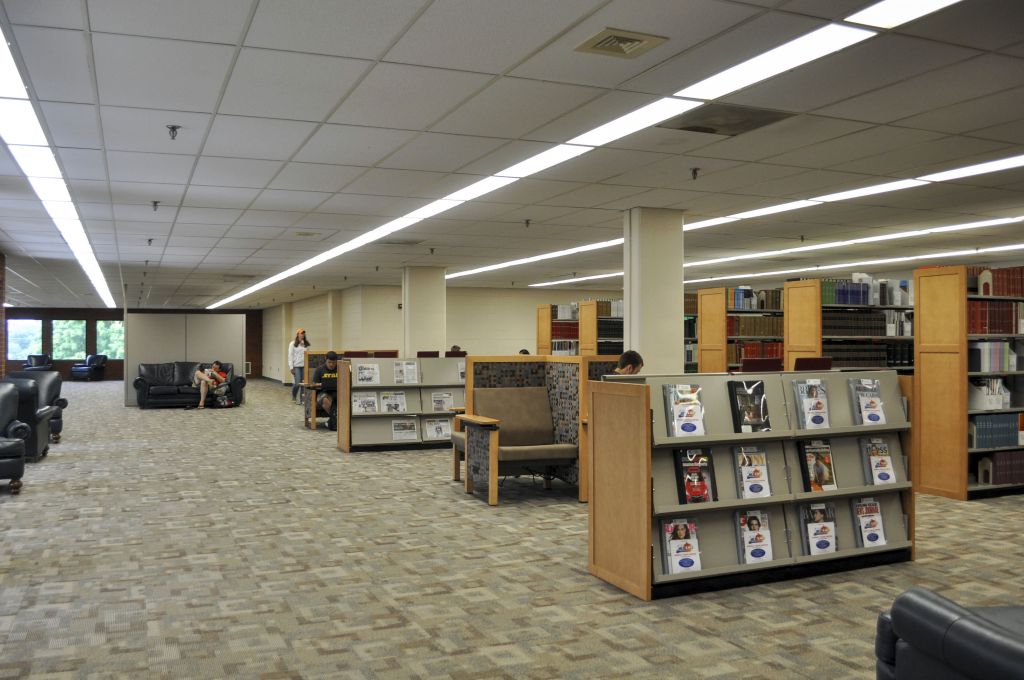
Students utilize resources found on the renovated third floor of Waterfield Library. The project consisted of new carpet, paint and additional study spaces.
The third floor of Waterfield Library has opened up in more ways than one.
The newly renovated quiet floor opened to students Aug. 27 at 6 p.m.
With old books catalogued online, bookshelves no longer crowd the floor’s space. The new floor plan is more open.
The $211,358 project brought new carpet, paint, and additional study spaces. New pin-wheel-like seating creates desks for four students to share per unit, and new study rooms create spots for one to two students to buckle down.
Planning for the renovation began two years ago. Adam Murray, dean of University Libraries, said the project was a team effort.
“We’ve put a lot of work into making this transformation happen,” Murray said. “The complete lack of study rooms in Waterfield was the primary factor that initiated planning for the project.”
Originally budgeted at between $225,000 and $250,000, the floor’s renovation fell below budget at its completion two weeks ago. Murray said some cuts had to be made to the designs in order to fit the budget.
Sarah Williamson, freshman from Tuscaloosa, Ala., attended the opening ceremony along with President Bob Davies and several other Regents. Williamson said she is a fan of the new design.
“It’s really open and nice,” Williamson said. “They have some good study spots up here. I really like that it’s silent. I’ve been needing that.”
Erin Passmore, library assistant, said she is excited for students to get to utilize the new study rooms most of all, as well as the new charging stations.
“They’re really great if you need to get away and not be distracted,” Passmore said. “Lamps are going to be added, and you can have you and a friend in there with you if you want.”
The study rooms are equipped with a desk, two chairs and outlets. Each room is available for checkout in 4-hour time frames for quiet or silent study.
Since there has been an increase in the number of students utilizing Waterfield, new seating and new spaces for charging laptops and phones were needed.
For the first time, Waterfield welcomed 4,000 students in just one day last semester.
“Finals time is always crazy,” Murray said. “Seating is at a premium. We’d have students sitting on the floor trying to study and plugging in their laptops. We wanted to utilize that space as much as possible.”
In order to free up floor space, librarians had to catalogue old books, making sure they were on the online database before getting rid of the hard copies.
The books still left on the third floor are bound periodicals, journals and rare books.
“I hope that students enjoy the transformed floor as much as we have enjoyed seeing it transition,” Murray said. “I fully anticipate that the study rooms will become highly sought-after services provided by the University Libraries, so much so that we will need to plan for further study rooms.”
A battle continues within Waterfield, a building built in the 1950s, with an electrical system that has not been updated since 1978.
The old electrical system limits the number of desktop computers Waterfield can hold.
With record-breaking visitor numbers, the scarcity of computers has become a frequent dilemma.
Even with the implementation of a new network, last year brought new problems: a flooded network that could not handle more laptops, and concerns over the structure itself withstanding the growing traffic.
After the Board of Regents rejected a proposal from former President Randy Dunn for a new library, a new proposal was submitted for a Waterfield annex.
The new structure would be attached to Waterfield, possibly taking the place of Woods Hall.
Renovations planned for the building also include a new heating and air system, new handicap accessible bathrooms – the current ones are on the third floor – and a new electrical system.
Projections for the cost of future renovations are $2-3 million, and an additional $19 million for the annex.
Murray said all the libraries still need work, but they are heading in the right direction.
Story by Amanda Grau, Staff writer